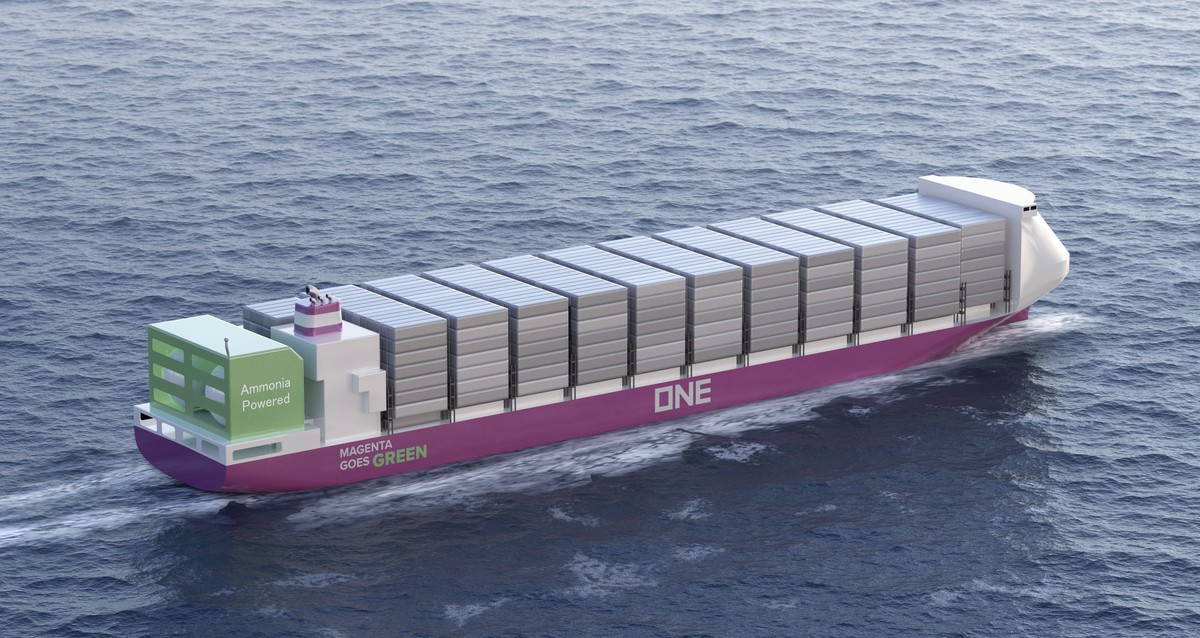The Week in Alternative Fuels 2 February 2024
A study this week showed that it is becoming more and more difficult to justify LNG's claim to sustainability, while other stories featured bunker fuel alternatives like ammonia, ethanol and methanol gaining traction.
 PHOTO: Ocean Network Express' concept of an ammonia-capable dual-fuel vessel. Nihon Shipyard
PHOTO: Ocean Network Express' concept of an ammonia-capable dual-fuel vessel. Nihon Shipyard
LNG-fuelled vessels have been touted as greener alternatives to those running on traditional oil-based fuels. But a new study by the International Council on Clean Transportation (ICCT) found that many of these ships actually produce more methane emissions than what current regulations assume, raising concerns about their overall impact on the environment.
According to the study, the plumes of 18 ships that use the most common type of LNG marine engine - low-pressure dual-fuel (LPDF) 4-stroke - showed an average methane slip of 6.4% in real-world measurements. Around 86% of the global LNG-fuelled fleet is fitted with these LPDF 4-stroke engines, according to ICCT data estimated using its systematic assessment of vessel emissions model.
Another position against LNG was presented by the environmental non-profit Opportunity Green. It argued that by relying on the Energy Efficiency Design Index (EEDI) in its revised taxonomy, the EU will allow a host of LNG-capable ships to be eligible for green investments by only promising reductions in onboard carbon dioxide (CO2) emissions, and not their lifecycle CO2 emissions. “Well-to-wake emissions are what we need to look at for climate change,” Opportunity Green’s legal director Carly Hicks told ENGINE.
Opportunity Green’s Hicks pointed out that the EU taxonomy also does not specify a “minimum level" for methane slip reduction to qualify for green investments. In a similar vein, the ICCT study authors recommended that EU and IMO’s policymakers should consider raising the minimum methane slip value for LPDF 4-stroke engines to 6% to match the real-world measurements they observed.
In the meantime, more and more shipping companies across segments are considering running some of their ships on alternative bunker fuels such as methanol, ethanol and ammonia that boast a zero-emission potential.
Danish shipping major A.P. Moller-Maersk launched the world's first large container ship capable of operating on methanol at the HD Hyundai Heavy Industries shipyard in Ulsan, South Korea. It is the first of 18 vessels due for delivery between 2024 and 2025. The Ane Maersk will undertake its first journey using green methanol from Ningbo, China, Maersk said. It will stop at Shanghai, Tanjung Pelepas and Colombo before arriving in the Port of Hamburg.
Purus Marine is looking at ethanol as its future fuel of choice. The UK-based shipowner has ordered yet another dual-fuel very large ethane carrier (VLEC) that can run on ethanol along with conventional fuels. The order now brings its total count of ethanol dual-fuel VLECs to three.
Japanese shipping company Ocean Network Express (ONE) has received DNV’s class approval for its ammonia-capable vessel concept. Ammonia-capable means that the 3,500-TEU capacity vessel will be able to run on ammonia along with conventional fuels upon delivery. “Ammonia is definitely one of the primary focuses of our research as ammonia fuel has a great potential of generating lower GHG emissions than conventional marine fuels,” Koshiro Wake, senior vice president at ONE, said.
By Konica Bhatt
Here is our selection of the top five alternative fuels stories from this week:
LNG-fuelled ships emit more methane than previously estimated – ICCT
INTERVIEW: EU definition only covers half of shipping emissions – Opportunity Green
Maersk launches world's first large container vessel powered by methanol
Purus Marine takes ethanol dual-fuel VLEC count to three
ONE gets DNV nod for ammonia-capable dual-fuel vessel concept





